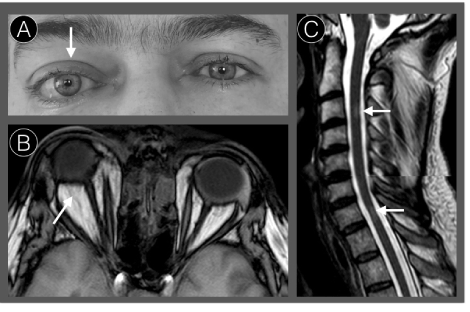Here we present a clinical case of a unilateral exophthalmus which occurred for the first time in an acute episode of multiple sclerosis (MS). Diplopia occurred together with a new paresis of the left hand. Concerning the paresis of the hand, a cervical spinal lesion was found, whereas the cause of the diplopia is most likely a protrusion of the right eye. Diplopia improved slightly under a cortisone regime. Laboratory study and thyroid ultrasonography did not reveal an endocrine cause of the exophthalmus and the physiological relationship to MS remained elusive. However, a type of autoimmune-overlap syndrome must be considered [1-3].

Figure 1. Exophthalmus in an acute MS episode. (A) Clinical presentation of exophthalmus of the right eye (arrow) and diplopia. (B) Transversal T2-weighted MRI with protrusion of the right eye and proliferation of intra-orbital fat tissue (Comerci, Elefante et al. 2013). (C) Sagittal T2-weighted MRI with two spinal lesions (arrows), the lesion in the upper cervical spine (C3, upper arrow) showed gadolinium enhancement and was most likely the reason for the acute paresis of the left hand.
- Comerci M, Elefante A, Strianese D, Senese R, Bonavolonta P, et al. (2013) Semiautomatic regional segmentation to measure orbital fat volumes in thyroid-associated ophthalmopathy. A validation study. Neuroradiol J 26: 373-379. [Crossref]
- Marrie RA, Reider N, Cohen J, Stuve O, Sorensen PS, et al. (2015) A systematic review of the incidence and prevalence of autoimmune disease in multiple sclerosis. Mult Scler 21: 282-293. [Crossref]
- Niederwieser G, Buchinger W, Bonelli RM, Berghold A, Reisecker F, et al. (2003) Prevalence of autoimmune thyroiditis and non-immune thyroid disease in multiple sclerosis. J Neurol 250: 672-675. [Crossref]
2021 Copyright OAT. All rights reserv
Editorial Information
Editor-in-Chief
Andy Goren
University of Rome "G.Marconi"
Article Type
Clinical Image
Publication history
Received date: August 09, 2016
Accepted date: September 13, 2016
Published date: September 16, 2016
Copyright
© 2016 Brodoehl S. This is an open-access article distributed under the terms of the Creative Commons Attribution License, which permits unrestricted use, distribution, and reproduction in any medium, provided the original author and source are credited.
Citation
Brodoehl S, Liebermann J, Herfurth J, Lobenstein S (2016) Unilateral exophthalmus in an acute episode of MS. Clin Case Rep Rev 2: DOI: 10.15761/CCRR.1000273.
Corresponding author
Brodoehl Stefan
Department of Neurology, University Hospital Jena, Germany.
E-mail : bhuvaneswari.bibleraaj@uhsm.nhs.uk

